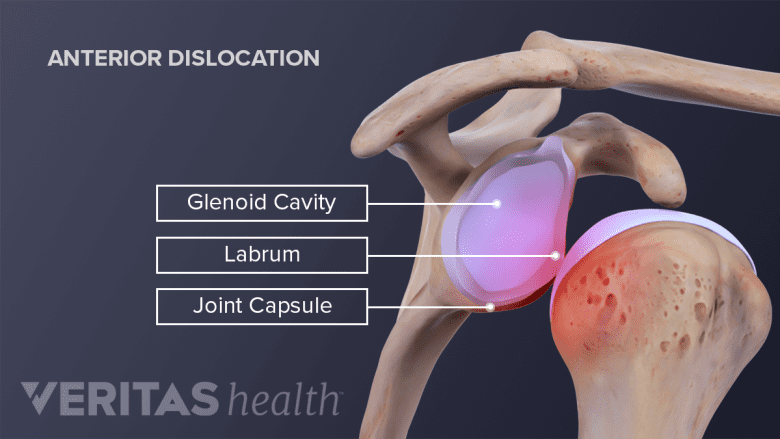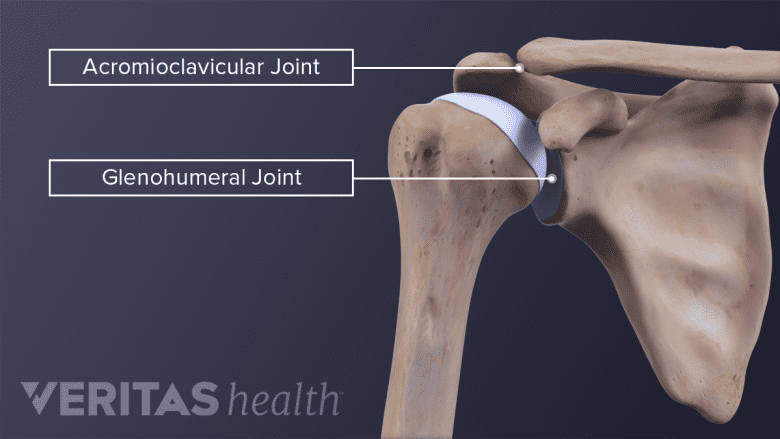When the shoulder dislocates, the round part of the upper arm bone, called the humeral head, is forced out of shoulder’s socket. A shoulder dislocation is often painful and requires a medical professional to move the humeral head back into place.

Shoulder dislocations occur when the humeral head is forced out of the shoulder socket.
The Shoulder Joint Is Flexible but Vulnerable
The main shoulder joint's ball-and-socket structure offers the most mobility of any joint in the body. This joint, technically known as the glenohumeral joint, is held in place by a network of muscles, tendons, and ligaments—primarily the ring of tendons known as the rotator cuff and a membrane that encases the shoulder joint, the joint capsule.
See Soft Tissues of the Shoulder
The tradeoff for the flexibility of the shoulder joint is the potential for the joint to become unstable. The glenoid, or socket, is relatively shallow and flat, so there is potential for the humeral head to become displaced, especially at the front (anterior) of the joint. Most of the time, it requires a trauma force to dislodge the shoulder joint.
In This Article:
- Shoulder Dislocation Injury (Dislocated Shoulder)
- Dislocated Shoulder Symptoms
- Causes and Risk Factors for a Dislocated Shoulder
- Diagnosing a Dislocated Shoulder
- Treatment for a Dislocated Shoulder
- Surgery for Dislocated Shoulder
Shoulders Can Dislocate in Different Directions
A shoulder dislocation or subluxation can occur in several directions:

An anterior dislocation is the most common type of shoulder dislocation.
- Anterior (forward) dislocation is when the humeral head moves toward the front of the body. Anterior dislocations make up over 90% of dislocated shoulders.1Dumont GD, Russell RD, Robertson WJ. Anterior shoulder instability: a review of pathoanatomy, diagnosis and treatment. Curr Rev Musculoskelet Med. 2011;4(4):200-7. This injury can be caused by sports or a fall on an outstretched arm.
- Posterior (backward) dislocation occurs when the humeral head moves toward the back of the body. It accounts for 2 to 4% of shoulder dislocations, and is usually caused by a hit during an athletic event, electric shock, or seizure.2Pedowitz R, Chung CB, Resnick D. Magnetic Resonance Imaging in Orthopedic Sports Medicine. Springer Science & Business Media; 2008. However, posterior subluxations (partial dislocations) are very common in athletes such as offensive lineman or weightlifters.
- Inferior (downward) dislocation occurs the least often—accounting for only 0.5% of shoulder dislocations3Saseendar S, Agarwal DK, Patro DK, Menon J. Unusual inferior dislocation of shoulder: reduction by two-step maneuver: a case report. J Orthop Surg Res. 2009;4:40.—and results in a downward movement of the humeral head. This type of dislocation can be caused by weight or force being applied to the arm as it is extended away from the body.
Knowing the direction of dislocation helps the physician craft a diagnostic approach and create a treatment plan.
Separated Shoulder vs. Dislocated Shoulder

The acromioclavicular and glenohumeral joints allow shoulder and arm movement.
It is important to distinguish between a dislocated shoulder and a separated one, since these are two different shoulder injuries.
A dislocated shoulder affects the glenohumeral shoulder joint, in which the humeral head comes out of the shoulder’s socket. By contrast, a separated shoulder involves another joint in the shoulder, the acromioclavicular joint. This joint is at the top of the shoulder, where the collarbone and shoulder blade come together. A separated shoulder means injury to the ligaments keeping these bones together.
Both dislocated and separated shoulders are commonly seen in athletes.
- 1 Dumont GD, Russell RD, Robertson WJ. Anterior shoulder instability: a review of pathoanatomy, diagnosis and treatment. Curr Rev Musculoskelet Med. 2011;4(4):200-7.
- 2 Pedowitz R, Chung CB, Resnick D. Magnetic Resonance Imaging in Orthopedic Sports Medicine. Springer Science & Business Media; 2008.
- 3 Saseendar S, Agarwal DK, Patro DK, Menon J. Unusual inferior dislocation of shoulder: reduction by two-step maneuver: a case report. J Orthop Surg Res. 2009;4:40.

